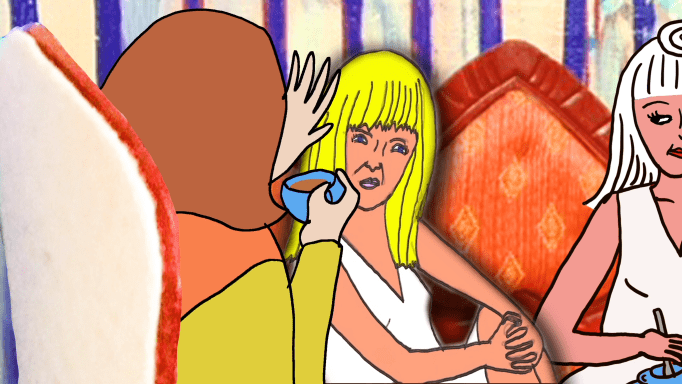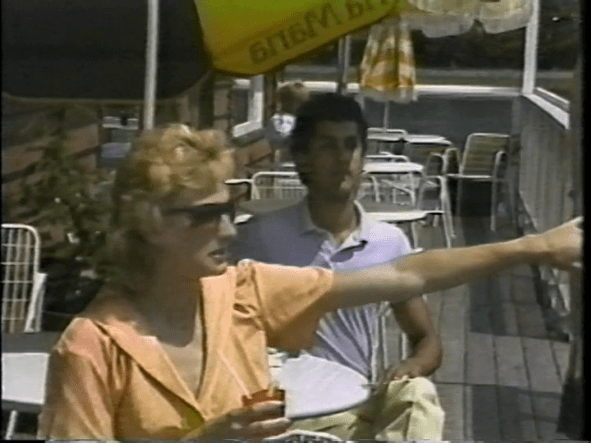THE WHOLE GRIMOIRE
A screening – in person and online
Tuesday Sept 20
8pm ATL / 7pm Eastern IRL screening (online – links below)
9pm ATL / 8pm Eastern Q+A IRL and (online Zoom)
The Blue Building Gallery
2482 Maynard St, Halifax, NS B3K 3V4, Canada
Laura Harrison and Paul Wong in Conversation
When we first saw Prime Cuts by Paul Wong, we had just moved to Vancouver BC from Nova Scotia. We were video artists in our twenties and we were hungry for everything: friends, glamour, heroin, gossip, art, justice, knowledge, meaning, beauty, validation, jobs. And we found all those things on Main Street: at Video In and The Western Front, two artist run centers with reputations that certainly exceeded their operating budgets; and at Main and Hastings, a neighborhood with international renown for its open-air drug market and as the site of the first needle exchange in North America.
We already knew Wong’s (in)famous work 60 Unit Bruise, in which his lover Kenneth Fletcher, tenderly injects 60ml of his own blood into Wong’s back. The work was made in 1976, preceding the onset of the AIDS epidemic, and we saw it in probably 98, the year Clinton declared that the AIDS crisis had risen to the level of a “severe and ongoing health crisis”. This was a big deal because in the intervening years Reagan and Bush-the-Elder had done their best to erase people with AIDS, despite HIV being the leading cause of death among Americans aged 25-44 for most of the years of his reign. The AIDS reading of the Wong’s eerily prescient piece eclipsed any other analyses at that point, but we saw different things in it as well: how stylish it was, how iconic, how cool, how sad, how brave. It made us see that the gutter and the art world were adjacent—We could make art from the gutter, and it could be stylish and profound. This was exciting.
It sliced open the teal-and-dusty-rose underbelly of West-Coast yuppiedom.
And then we saw Prime Cuts, which performed surgery from the gutter. It was that precise. It sliced open the teal-and-dusty-rose underbelly of West-Coast yuppiedom. It was a nuanced, Brechtian sendup of the horrible people of the 80s, and it was clear to us from this work that Wong understood that style is something to be taken seriously: it’s somewhere form and content tighten into a tiny, unpickable knot.
We knew that Wong, like us, had been a heroin user, but when he swept into Video In trailing expensive grooming smells and acolytes, none of us saw anything but a star, forged in fire. There was no whiff of madness, save that which made him smell more world-wise and complex.
I’m allergic to the word “redemptive” in relation to drugs and sobriety, but Wong’s work made us feel like we could still become people with brains and gravitas and sway; that our willful uncoupling from reason didn’t necessarily mean we would be stripped of our right to choose how and whether we were seen. This, we know from Hurston (who insisted on being seen and showing where she came from) to Abounaddara and Glissant (who insist on the right to control ones image, to become opaque), is a basic right of all beings, and it’s a slow violence to live a life deprived of that right. It can make a creature howl, hide or preen until she bleeds.
So when we started to build The Infernal Grove, we reached out to Paul right away to see if he would be comfortable talking to us about drugs, addiction and recovery (not necessarily in that order). He talked about many things including NA, about how it was there that he was finally able to let go of the shame he felt about his drug use. “They say you only hurt yourself,” he said “but I reject that. I don’t really feel that hurt.”
I won’t say that the cinema holds the potential for boredom…
We saw Laura Harrison’s animation Limits of Vision this March at The Museum of Moving Image. For context, I shall just let it be known that for some among us, the cinema is a fearsome place. The expectation of stillness and quiet can feel like a heavy, hateful hand gripping our shoulder while one tries, tries, tries to pay attention, to not crunch or squirm or speak. I won’t say that the cinema holds the potential for boredom, because (again, for some of us) that is foregone. I won’t say, either, that experimental work poses a special threat, because everyone already knows that.
But Limits of Vision had me transfixed from its strange opening salvo, which comes in a form oddly reminiscent of the text crawl from Star Wars. It’s a quote from Jesuit mystic and evolutionary scholar which reads:
“Once and for all she understood that like the atom, woman has no value save for that part of herself that passes into the universe.”
— Emily Vey Duke
Description
The Infernal Grove Study Groups bring into dialogue a group of artists from across the continent who have lived experience with substance-use, and who represent a range of current relationships to sobriety and its alternatives. This session, moderators will include Liz Roberts, Mikiki, Devon Narine-Singh, Cooper Battersby and Emily Vey Duke
The study group was formed as a space for conversations about both ideas and feelings: emotional conversations about the academic and critical conversations about affect. In recovery programs, perhaps by necessity and certainly by design, there is a push to accept received wisdom. But for addict-intellectuals, it’s hard to forfeit critical thinking to recovery. In addiction, connection to the intellectual can become tenuous. It’s easy to lose the relationships and identities that support rigorous critical thinking. Recovery can mean recovering those relationships and identities.
VSW will host a week-long online screening of two works chosen Emily and Cooper for The Infernal Grove. Prime Cuts (1981, 20 minutes, Paul Wong); and The Limits of Vision 2022, 30 minutes, Laura Harrison). Moderators will discuss the works in relation to the project of The Infernal Grove.
The study group is part of The Infernal Grove Project, an unsystematic structural analysis of drug use, addiction and recovery (not necessarily in that order). It is anti-carceral, anti-prohibition and seeks to amplify the voices of radical harm-reductionists and their coalitions.
The Infernal Grove Project takes place mostly on stolen Mi’kmaq and Onondaga land.
The text for this episode of the Study Group is a screening: Read the descriptions and watch the two films below.
THE INFERNAL GROVE PRESENTS
THE WHOLE GRIMOIRE

The Limits of Vision
2022, 30 minutes
Laura Harrison
The Limits of Vision, based on Robert Irwin’s novel of the same name, features Marcia, a trapped housewife navigating shifting gender norms of early 1970’s South London, her coterie of undermining friends, and a dust king named Mucor, god of small things. The film touches on mortality, painting, white feminism, slippage, the impossibility of moral purity, and non attachment.

Prime Cuts
1981, 20 minutes
Paul Wong
Prime Cuts is a funny, sharp sendup of the yuppie takeover in 80s Vancouver. It’s about style, technology and sexuality. Delivered in an unpolitical and distanced view, not unlike a commercial, we see life as an endless stream of sensuality. Complete with state-of-the-art accessories, beautiful young adults work out, make out, frolic in the sun, and dance until dawn.
Previous Screenings
May 12 2022 Visual Studies Workshop
